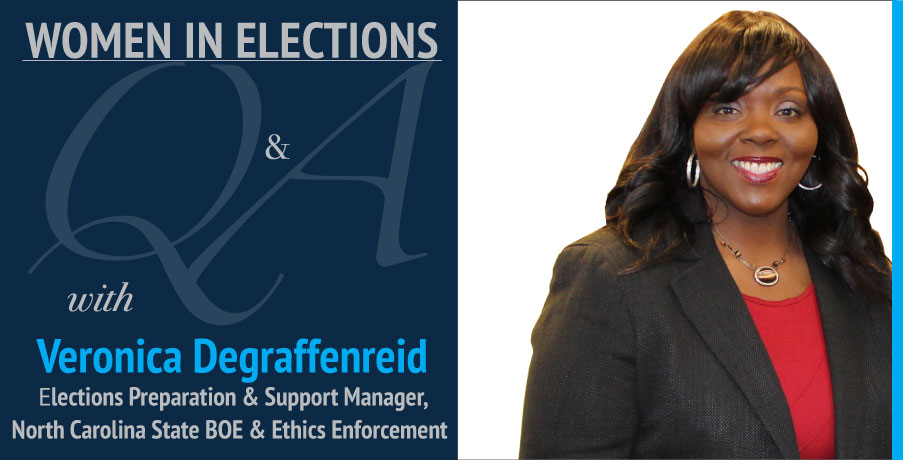
The EAC has launched a “Women in Elections” campaign to coincide with Women’s History Month. During March, using EAC’s Facebook, Twitter and Instagram accounts, we will interview several women at the heart of elections at federal, state and county levels about their elections experiences. We look forward to sharing their insights. Follow the conversation online at #WomeninElections.
Today, we are continuing the series with a conversation between EAC Vice Chair Christy McCormick and Veronica Degraffenreid, Election Preparation & Support Manager for the North Carolina State Board of Elections & Ethics Enforcement (State Board).
Christy, EAC: Thank you for joining me for this series, Veronica. I wanted to start by asking you how your career in elections began.
Veronica, State Board: Before coming to the State Board, I spent 8 years as a Legal Assistant to the Special Litigation Division of the North Carolina Department of Justice. Much of our “special” litigation was focused on defending the state’s various redistricting plans and other election-related matters, so I had a strong background in these issues when I joined the State Board of Elections.
Christy, EAC: You have served on the North Carolina State Board of Elections for over a decade now. You’ve been a vocal advocate for modernizing election systems and auditing data to improve voter experience and increase auditability. Can you describe some of the updates and innovations you have seen in North Carolina’s election systems?
Veronica, State Board: Since I began working with the State Board of Elections, two central themes have guided my work:
- We are better together …
- Better data drives better processes, and better processes drive better data
That we are better together has been demonstrated in the relationships we have with multiple state, local and federal agencies. Within the state, we have expanded our partnerships with the NC Department of Motor Vehicles and the NC Department of Health and Human Services. Increased communication and understanding of our respective roles has created relationships that bridge the ordinary “turf” divide that separates state agencies.
Within North Carolina’s 100 counties, we work with local departments of social services and WIC agencies (nutrition programs for Women, Infants & Children) on administering the state’s NVRA program. Again, by reaching out and directly engaging people in positions of responsibility within those agencies, we overcome bureaucratic barriers to cooperation. We also work closely with county GIS agencies and county IT departments, which serve our county boards of elections by providing data that is crucial to our ability to determine district and even county boundary lines.
On the federal level, we work with the United States Postal Service in every election cycle to keep them updated on upcoming deadlines and challenges that may arise because of legal requirements for certain types of election mail. We are also benefiting from our relationship with the Department of Homeland Security in continually monitoring the security of our systems.
These state, local and federal partnerships have upgraded the quality of election administration by:
(1) facilitating citizens’ access to voter registration and voting;
(2) improving election data;
(3) providing for the ability to better maintain the voter rolls; and
(4) strengthening the integrity and security of our elections system.
As the business manager for our election technology program, I have been a part of several innovations in North Carolina that have led to better data and processes. For example, we use GIS technology to audit jurisdictional assignments within our voter registration system, which is essential to ensure that voters are assigned to the correct election districts. Another innovation is that in 2014, we moved away from a vendor-based election reporting application and developed our own distribution application and web-based results display solution. This particular development has dramatically improved our ability to audit election inputs and outputs, from ballot configuration, election night reporting, through election canvassing and post-election audits.
Christy, EAC: There were various shifts in election administration procedure in North Carolina ahead of the 2016 federal election. How did you communicate these changes to county election officials, and did these changes improve elections?
Veronica, State Board: In the lead up to the 2016 elections, we dealt with several major changes to election administration in North Carolina. As part of our preparation, our agency developed comprehensive resources for state election officials, which included training videos and a fairly detailed election official resource guide for chief judges.
We also provided every North Carolina voting site with a station guide. Thousands of these guides, which are standing flip books that are easily positioned on desks, were distributed to almost 3,000 sites throughout the state. Their purpose was to remind election officials about updated voting site procedures, and provide guidance on the best way to assist voters experiencing issues at polling places.
Christy, EAC: You have been a member of the EAC’s Standards Board since 2015. What has the impact of that involvement been on you, your state and your voters?
Veronica, State Board: It has been truly rewarding to engage with others within the national election community as we collaborate on shared goals and challenges.
We at the EAC would like to thank Veronica for her insight. Keep checking our blog for conversations with “Women in Elections” throughout Women’s History Month and help us celebrate these leaders in the election community.

